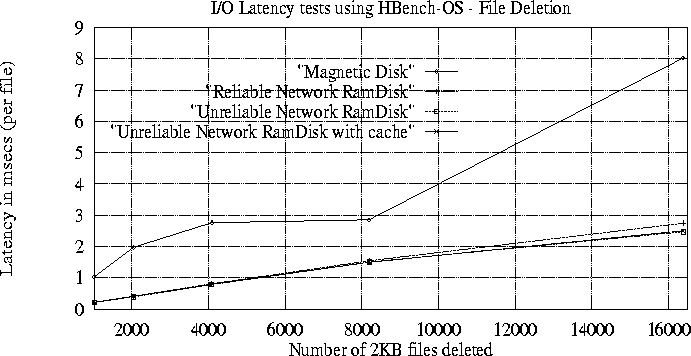
To measure the I/O Latency of all versions of the Network RamDisk over the ATM (LANE) interconnection network and compare it with the magnetic disk performance, we ran the lat_fs microbenchmark program creating and deleting a variable number of 2KB files, measuring the latency for each file reported by the benchmark.
Figure 12: Comparison of the I/O Latency performance of the Linux NRD
Client on the Magnetic Disk vs. Network RamDisk over the Ethernet and
the ATM interconnection network, using HBench-OS:
This test measures the latency of performing certain file
system metadata operations, in particular random file deletions. The
latency shown is the number of milliseconds (ms) per file
deletion for a variable number of 2KB file deletions on each of the devices.
The benchmark were executed from user level on a Pentium II 233Mhz PC
with 64MB of main memory running Linux 2.0.33, and
compiled with the GNU C compiler (gcc 2.7.2.1).
The Network RamDisk used as servers two Sun Ultra 1 workstations,
each with 128 MBytes of main memory and Sun ATM NIC,
running Solaris 2.6 .
The results of lat_fs for the file creations on all versions of the Linux NRD Client on the ATM, and the magnetic disk are illustrated on figure 11 . It is obvious that every version of the Network RamDisk has much lower latency on the ATM, than the magnetic disk. For example for 16384 file creations of 2 KBytes each, the creation time for each file on the magnetic disk is equal to 12.629 milliseconds (or 79 files per second), whereas with the unreliable version of Linux NRD on the ATM with block caching, the creation time is 7.601 milliseconds (or 131 files per second). The results of lat_fs for the random file deletions are depicted in figure 12 , where we can see that the performance of all versions of the NRD client is again superior compared to the the magnetic disk.
An important conclusion derived from figures 11 and 12 is that the reliable version of the Linux NRD client with the adaptive parity caching policy, performs very close to the unreliable version. We conclude that the NRD can provide reliability, retaining its high performance.